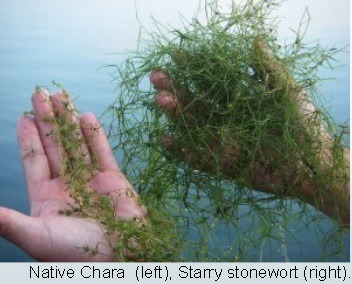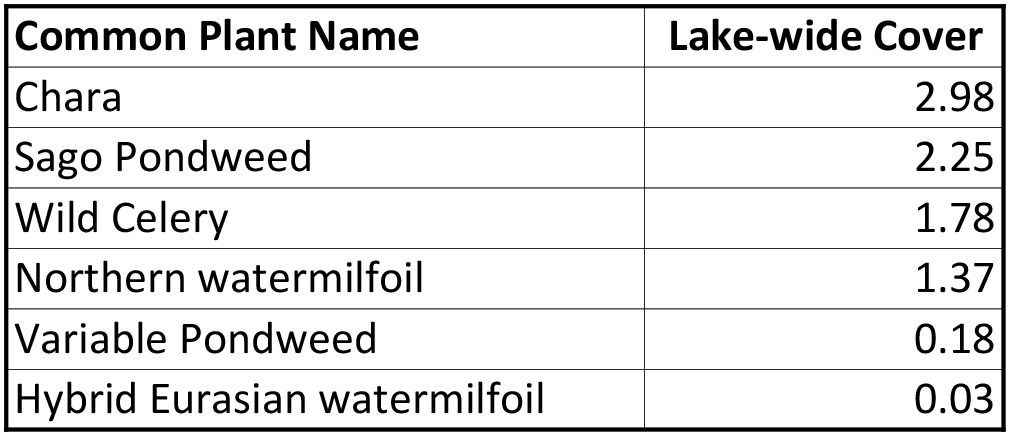 Clark Lake continues to guard against invasive species. Lakes that didn’t (or don’t) deal with Hybrid Eurasian Water Milfoil (HEWM) and Starry Stonewort face the consequences. Recreational, fishing, and habitat are threatened. Some lakes waited too late, and that affected property values.
Clark Lake continues to guard against invasive species. Lakes that didn’t (or don’t) deal with Hybrid Eurasian Water Milfoil (HEWM) and Starry Stonewort face the consequences. Recreational, fishing, and habitat are threatened. Some lakes waited too late, and that affected property values.
By 2014 at Clark Lake, something akin to an underwater jungle lurked below and was increasingly surfacing. Those who had to pause their raft ride to clear their prop may remember the experience. That exotic growth likely began earlier than 2014, but had become painfully noticeable by then. A group of Clark Lake residents came to the defense. With overwhelming support form the Clark Lake community, a special assessment district (SAD) was formed, and PLM was contracted for treatments.
 The photo was taken as the weed control project began.
The photo was taken as the weed control project began.
In their first survey, PLM found that “Eurasian water milfoil was in approximately 32% of the 63 sites surveyed. In addition, genetic testing of the milfoil plants by Grand Valley State University found that many of the samples collected were of a hybrid milfoil, a cross between native milfoil and the exotic Eurasian watermilfoil. Hybrid milfoils tend to be more difficult to control and grow back rapidly following control efforts. Management efforts to date have focused on controlling this hybrid milfoil in Clark Lake.”
Where does that leave the lake today? On June 21st, PLM treated 4.6 acres of Clark Lake for HEWM. “During the September survey, only two of the sixty-five survey sites contained Eurasian watermilfoil. Both sites are in the northeast corner of the lake, adjacent to the County Park. Although the plants were clearly impacted by treatment, it appears as though some of the plants may survive.” Clark Lake’s situation has improved significantly.
 Another threat is Starry Stonewort. This plant masquerades as Chara. PLM says “Chara is a highly desired species because it is typically low growing, keeps the water clear and can slow down the invasion of exotic weed species. Starry stonewort also forms dense mats, but unlike Chara, it can grow from 5 to 7 feet tall. Starry stonewort can be very detrimental to a lake’s ecosystem and has the ability to kill off native plants and have a negative impact on a lake’s fisheries.” The good news? No Starry Stonewort was found in the September survey. Previously Starry showed up near the County Park and Eagle Point. You might say Clark Lake nipped it in the bud.
Another threat is Starry Stonewort. This plant masquerades as Chara. PLM says “Chara is a highly desired species because it is typically low growing, keeps the water clear and can slow down the invasion of exotic weed species. Starry stonewort also forms dense mats, but unlike Chara, it can grow from 5 to 7 feet tall. Starry stonewort can be very detrimental to a lake’s ecosystem and has the ability to kill off native plants and have a negative impact on a lake’s fisheries.” The good news? No Starry Stonewort was found in the September survey. Previously Starry showed up near the County Park and Eagle Point. You might say Clark Lake nipped it in the bud.
The control program targets only invasive species. In some cases, non-invasive, native weeds can be bothersome. Residents may take it upon themselves to eliminate them. PLM makes the following comments about non-invasive weeds. “Aquatic plant management should preserve species diversity and cover of native plants sufficient to provide habitat for fish and other aquatic organisms. Native plants should be managed to encourage the growth of plants that support the Clark Lake fishery (by creating structure and habitat) provided that they do not excessively interfere with recreational uses of the lake (e.g., swimming and fishing) in high-use areas. Where they must be managed, management techniques that reduce the stature of native plants without killing them (e.g., harvesting, contact herbicides) should be used whenever possible. Specific areas should be set aside where native plants will not be managed, to provide habitat for fish and other aquatic organisms.”
This chart shows what’s growing in Clark Lake.

The fall survey also monitors water quality. Here’s what PLM says about Clark Lake:
- Minimum dissolved oxygen is adequate for good fish production.
- pH is within acceptable limits.
- Phosphorus and Nitrogen are within acceptable limits.
- No remedial action recommended at this time.

The cost to lakefront property owners is about $59 per year, and is included in the tax bill. The program is under the auspices of Columbia Township, and the tax money collected can only be used to control Clark Lake’s invasive weeds.











Good News staying on top of a problem that can explode over night
Great response and corrective actions. Thanks for your leadership. The lake looks fantastic.
Great article and thank you for the information. Thank you to all those who made this management effort possible.
Leave it better than you found it!
This is a good reminder to Clark Lakers that invasive weeds continue to plague our lake and, because of our research, continued efforts, and our partnership with PLM, the weeds are significantly reduced. We do not dare forget that the efforts to control the invasive species need to be ongoing. We’re staying ahead of the spread and that’s where we want to be.
While I applaud their efforts to control the invasive species, it appears they have killed off much more of the native weeds than they care to admit. During two different fishing trips in spring and late summer it was difficult not only to locate suitable fishing locations where there was good weed cover, but even those locations we tried bore very few fish. This used to be a very good fishing lake, with an abundance of bluegill, crappie, bass, pike, perch, and even walleye. Now it is a barren lake with very few good fishing “holes”. More of a balance needs to be found so that the lake can return to a more natural form, with recreation activities available for all.
Used to be stocked with Walleye years ago and now they are few and far between.
Seems as if they just would like to look at the lake and not utilize the benefits of having a lake.
I disagree with the statement that the efforts to control invasive weeds has “killed off much more of the native weeds than they care to admit”. The lake hasn’t been treated on lake wide basis in a number of years. Treatment efforts recently have been limited to spot treatments primarily near the county park that covered only 4.6 acres of the lakes 585 acres. Those treatments use chemicals that are designed to impact a specific weed without migrating to other areas of the lake. Today, I find that there are about the same number of weeds in the lake as in 1952, when I first became a resident of the lake. Fishing is just that, sometimes you have a good day and the next not so much.